The subject of this post is to review the privacy settings as well as security settings in the popular Firefox web browser. This web browser provides many settings in these two areas for its users, the most important of which we examine.
Source: Mozilla Firefox official website
These are the main topics you will read in this post:
- Remembering usernames and passwords
- Managing multiple accounts for a site
- Exporting login data
- Protecting your passwords
- Disabling the Password Manager
- Removing websites from the address bar suggestions
- Deleting individual form entries
- Alerts for breached websites
- Enhanced Tracking Protection
- Location-Aware Browsing
- How to generate a secure password in Firefox
- Managing camera and microphone permissions
- Phishing and Malware Protection features
- Secure website certificate

The Firefox Password Manager securely stores the usernames and passwords you use to access websites and then automatically fills them in for you the next time you visit a website. When you enter a username and password that you haven’t already saved for a website, Firefox will ask if you want to save it. You can also manually add website logins. Click the Menu button and select Logins and Passwords.
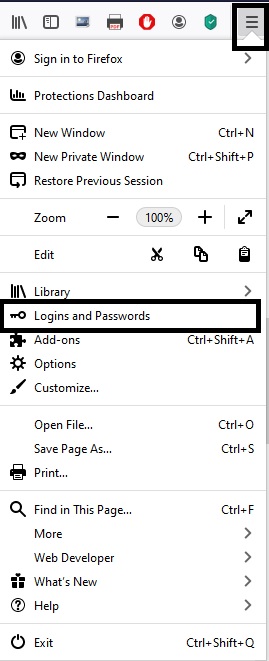
Select the Create New Login button at the bottom left side of the Firefox Lockwise page to manually add a website address, login, and password.
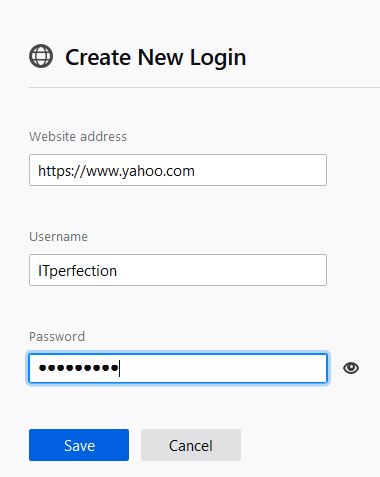

If you have more than one account for a site, Firefox can save all your logins. You can make Firefox fill in login information for a different account each time you visit.

If you want to back up your saved usernames and passwords or move them to a different application, you can export this data to a .csv (comma separated values) file.
1- Click on the menu button to open the menu panel.
2- Click Logins and Passwords. The Firefox Lockwise about:logins page will open in a new tab.
3- Click the Firefox Lockwise menu (three dots), then click Export Logins.
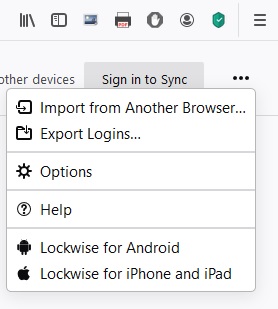
4- This warning appears and states that all your saved passwords will be saved in plain text in the output file. You must be very careful.
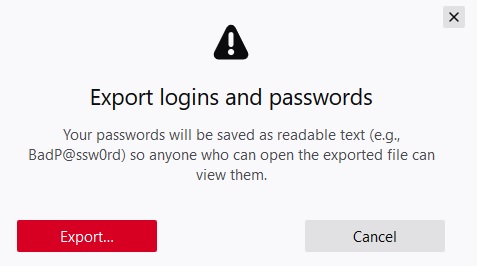
5- Click Export button.
6- You can choose the file name and location where this exported data will be saved.

Even though the Password Manager stores your usernames and passwords on your hard drive in an encrypted format, someone with access to your computer user profile can still see or use them. So, it’s better that use a Primary Password to protect stored logins and passwords.
Primary passwords are set locally and are not synced between profiles or devices. After you have defined and set your primary password, you will be prompted to enter it once for each Firefox session, when Firefox needs access to your stored passwords.
To create a primary password:
1- Click on the menu button to open the menu panel. Then click Logins and Passwords.
2- Click the Firefox Lockwise menu (three dots), then click Options. The Firefox Options Privacy & Security panel will open to the Logins and Passwords section.
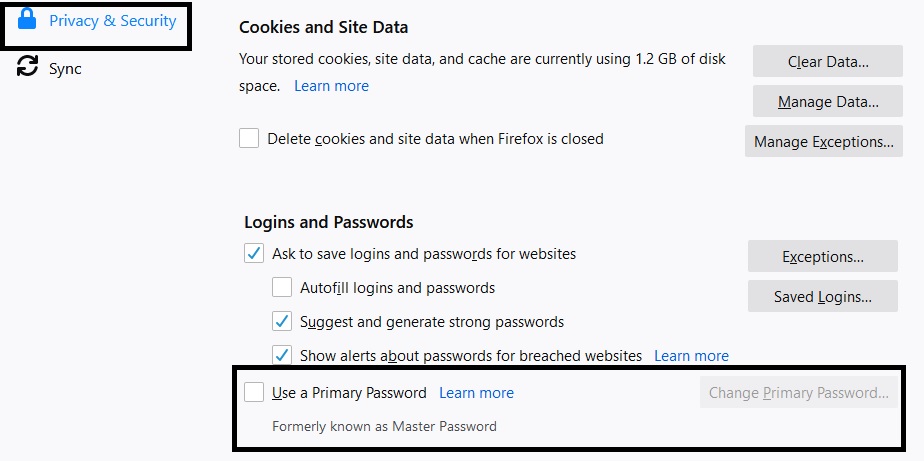
3- Put a checkmark next to Use a Primary password. The following dialog box appears:
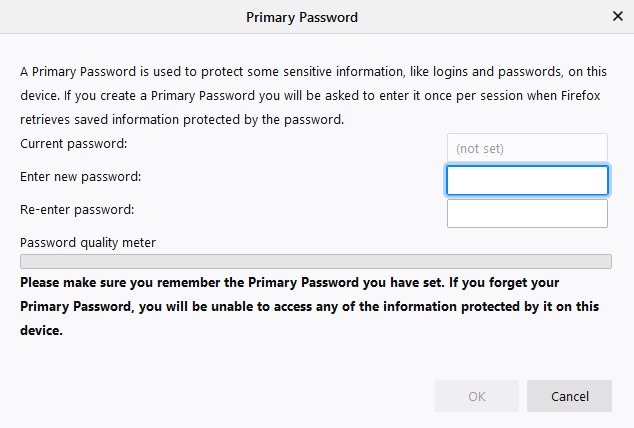
4- Enter your primary password. To create a quality password, your primary password should include (1) At least one capital letter (2) One or more digits, and (3) At least one non-alphanumeric character, such as: @ # $ % ^ & * ( )
5- To set the primary password, click OK.
6- Close the about:preferences page
For remove the primary password:
1- Click on the menu button to open the menu panel. Then click Logins and Passwords.
2- Click the Firefox Lockwise menu (three dots), then click Options. The Firefox Options Privacy & Security panel will open to the Logins and Passwords section.
3- Remove the checkmark next to Use a Primary Password.
4- Enter the current password to confirm your ownership of the account.
5- Click Remove.
6- Click OK in the dialog that appears to confirm its removal.
7- Close the about:preferences page.

Firefox offers to remember passwords by default. To change your settings:
1- Click the menu button Menu and select Options. Select the Privacy & Security panel and go to the Logins and Passwords section.

2- To prevent Firefox from saving logins and passwords for a certain website, click the Exceptions… button to the right of Ask to save logins and passwords for websites and add the website URL. To prevent Firefox from saving logins and passwords for all websites, remove the check mark next to Ask to save logins and passwords for websites.

To clearing a single item in the address bar history:
1- Type or paste enough text for Firefox to show the item in the drop-down.
2- Press the ↓ down arrow key or move the mouse, to highlight the browsing or Search history entry to delete.
3- To clear the highlighted item, hold down the Shift key and press Delete on your keyboard.
To clearing all items for a single site in the address bar history:
1- Click the menu button menu then click Library.
2- Click History and then click the Show All History bar at the bottom to open the Library window.
3- At the top right corner, type the name of the website you wish to forget in the Search History field, and press Enter.
4- Right-click on the site you wish to forget in the resulting list and select Forget About This Site.
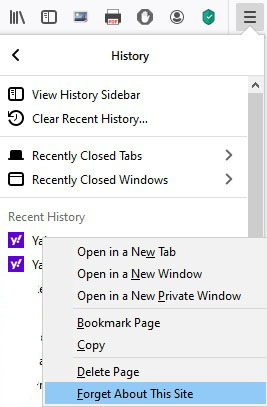
Finally, to clearing all items in the address bar history:
1- Click on the menu button, click Library and then click History.
2- Click Clear Recent History… to open the dialog window.
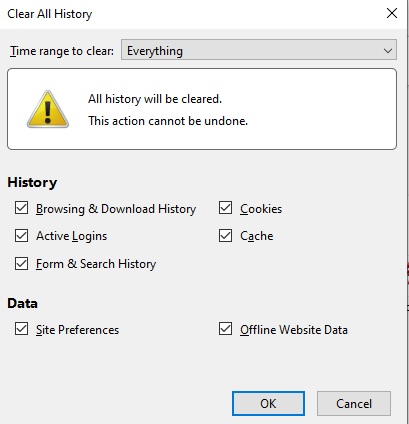
1- To remove browsing history, make sure Browsing & Download History has a check mark next to it. To remove Search history, check the box next to Form & Search History.
2- Click OK.

If you want to remove one of your previous form entries from Firefox’s history:
1- Click on the form field and press the ↓ key to display all the saved entries. You may type the first few letters of the entry to limit the number of entries displayed.
2- Use the ↓ key or the mouse pointer to highlight the entry you wish to delete.
3- Press Delete. The entry will be removed.
Repeat the process for each entry that you’d like to delete.
If you want Firefox to forget all of your previous form entries:
1- Click the menu button menu then click Library.
2- Click History, and then Clear Recent History….
3- In the Time Range to clear: drop-down, choose everything.
4- Click on the arrow next to Details to display the list of items that you can clear. Make sure Form & Search History has a check mark next to it.
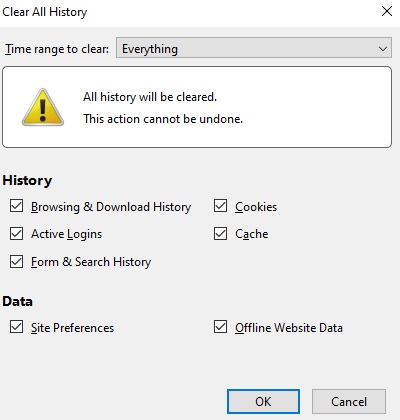
5- Click Clear Now.
To turning off Auto form fill and preventing Firefox from storing more form entries:
1- Click the menu button and select Options. Select the Privacy & Security panel.
2- In the drop-down menu next to Firefox will, choose Use custom settings for history.
3- Remove the check mark next to Remember search and form history.
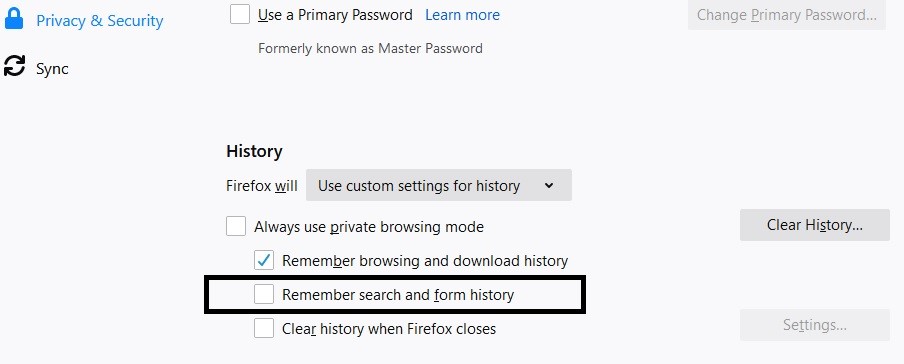

The Firefox Lockwise Password Manager shows alerts about logins that were potentially exposed in data breaches. Firefox checks to see if you’ve reused any of potentially vulnerable passwords with other logins you’ve saved to Lockwise. The browser does this by creating an encrypted list of your breached passwords, then checking it against all saved passwords.
To turning off website breach alerts in Lockwise:
1- Click the menu button and select Options.
2- Select the Privacy & Security panel and go to the Logins and Passwords section.
3- Deselect the checkbox for Show alerts about passwords for breached websites.
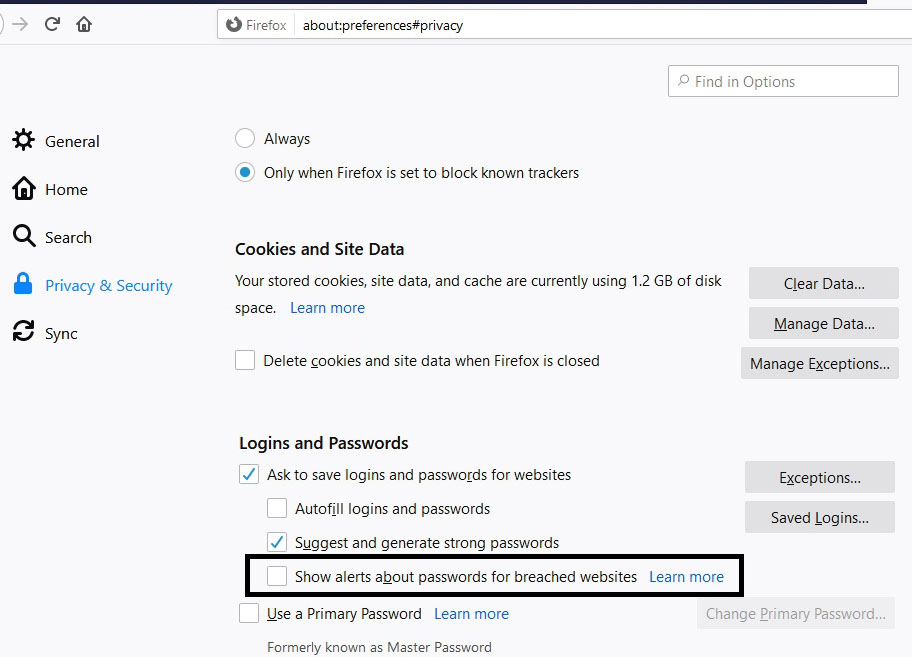
![]()
Content blocking was redesigned in Firefox version 70 and is now Enhanced Tracking Protection. It is a collection of Firefox privacy features that protect you from threats and annoyances on the Web.
By default, Firefox blocks the following types of trackers and scripts.
- Social media trackers: This tracker is a tool to measure the performance of social media brands. Social reports enable you to identify ways to improve your marketing campaigns.
- Cross-site tracking cookies: cross site cookie tracking is a way of tracking that detects and follows users on their journey across different websites. This is possible because of third party cookies.
- Fingerprinters: These scripts collect information about your browser and device configuration, such as your operating system, screen resolution, and other settings.
- Cryptominers: These scripts use your computer’s central processing unit (CPU) to invisibly mine cryptocurrency.
- Tracking content in Private Windows only: These trackers are hidden in ads, videos, and other in-page content. Blocking them can cause some websites to break.
The shield to the left of the address bar tells if you if Firefox is blocking trackers and scripts on a site.
![]()
- Purple: Firefox blocked trackers and harmful scripts on a site.
- Gray: No known trackers or harmful scripts were detected on a site. Gray and crossed out: Enhanced Tracking Protection is turned off on a site. Open the shield and toggle the switch to turn it back on.
- Gray and crossed out: Enhanced Tracking Protection is turned off on a site. Open the shield and toggle the switch to turn it back on.
If a site seems broken, try turning off Enhanced Tracking Protection. It allows trackers to load on that site only.
1- Click on the shield to the left of the address bar.
2- Toggle the switch at the top of the panel.
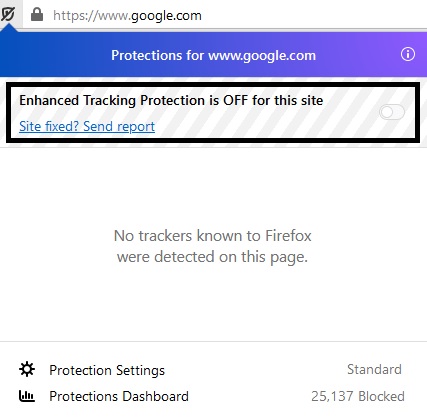
This will turn off Enhanced Tracking Protection for this site. The page will reload automatically and allow trackers on this site only.
Trackers are often hidden in the following types of content:
- Login fields
- Forms
- Payments
- Comments
- Videos
To view or change your Enhanced Tracking Protection settings for all sites:
1- Click the shield shield detected to the left of the address bar on any webpage
2- Select Protection Settings.
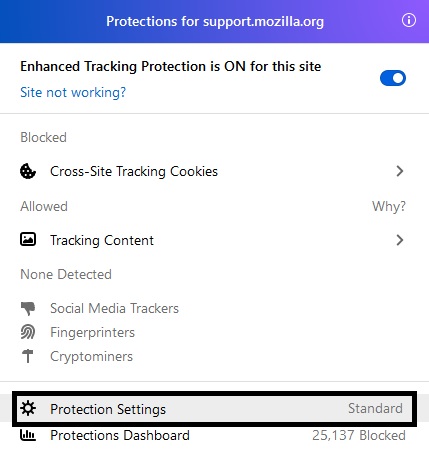
This will open the Firefox Options Privacy & Security panel in a new tab.
3- Now, to further increase privacy, select Strict Enhanced Tracking Protection.
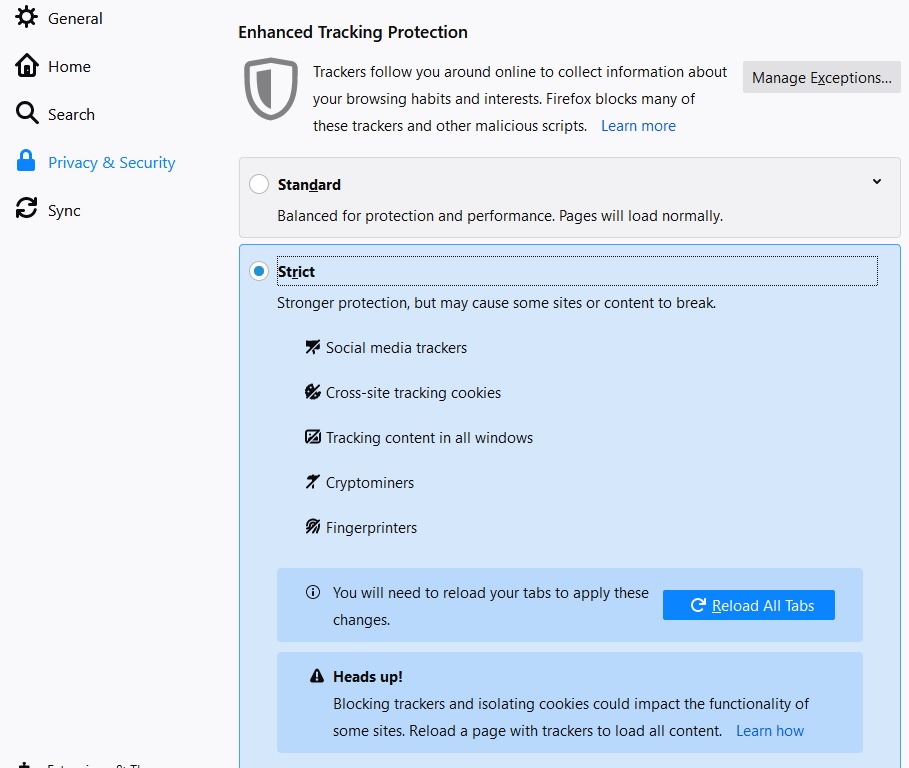
4- Select the Reload all tabs button to apply your new privacy settings.
You can to block some trackers and scripts, but not others. You can use Custom Enhanced Tracking Protection.
1- Click the shield shield detected to the left of the address bar on any webpage
2- Select Protection Settings. This will open the Firefox Options Privacy & Security panel in a new tab.
3- Select Custom.
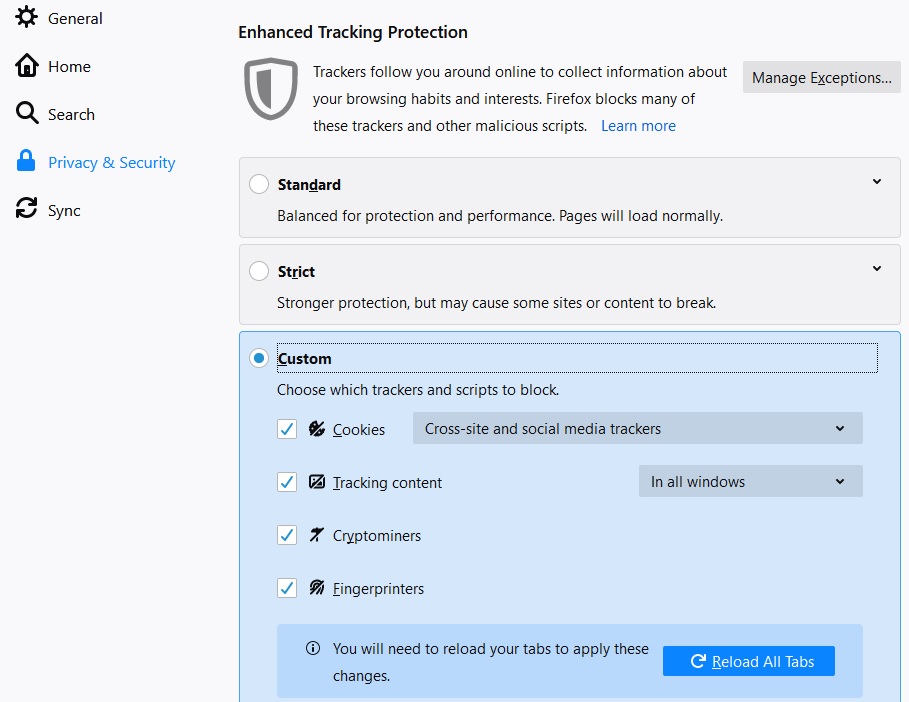
4- You can also turn off all protections in Custom, by deselecting all checkboxes.
5- Select the reload all tabs retina button to apply your new privacy settings.

Websites that use location-aware browsing will ask where you are located, in order to bring you more relevant information or to save you time while searching. Firefox doesn’t share your location without your permission. When you visit a location-aware website, Firefox will ask you if you want to share your location.
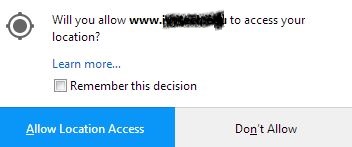
- If you allow location access, Firefox gathers information about nearby wireless access points and your computer’s IP address and sends it to the default geolocation service provider, Google Location Services, to get an estimate of your location. That location estimate is then shared with the requesting website.
- If you do not allow access, Firefox will not do anything.
You can set Firefox to automatically deny new permission requests to all websites, without asking:
1- Click the menu button and select Options.
2- Select the Privacy & Security panel and then scroll down to the Permissions section.
3- Under Permissions, click the Settings button to the right of Location.

4- You can find the desired website through the search box, select it and in the status column, specify one of the two allow/block mode for that site. If you select block status, also check-mark Block new requests asking to access your location.
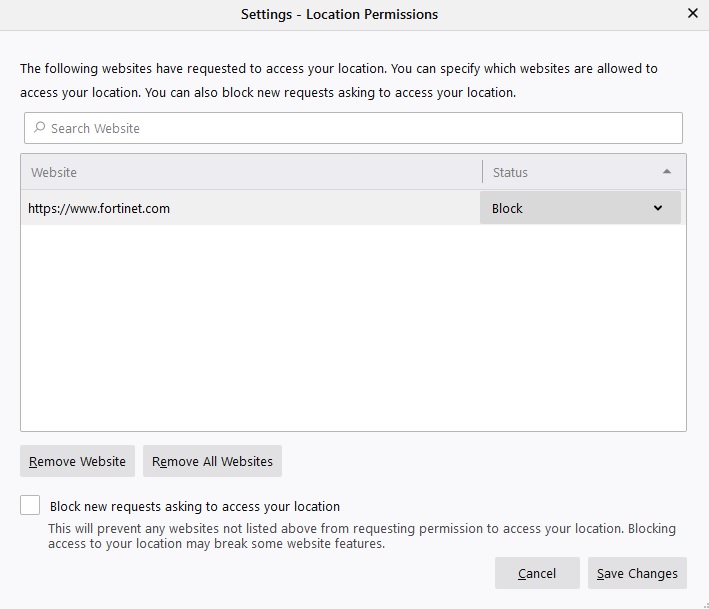
5- Click save changes.

When signing up for a new account on a website, Firefox can generate a secure password for you.
1- Click the password field on a website. The secure password option will automatically display.
2- Click Use a Securely Generated Password to fill in the field. Firefox will also save your new login for that site.

You can enable or block sites from accessing any one of your device’s cameras and microphones.
To use prompts to allow or block camera and microphone permissions for a site that uses these features:
1- Go to the desired site.
2- A confirmation pop-up displays asking if you want to share your device’s camera and microphone with that site. Your device’s default camera and microphone is selected from the designated drop-downs.
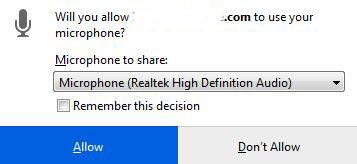
3- You can select a different camera and/or microphone.
4- Select the Remember this decision checkbox if you want Firefox to remember your selections for this site.
5- Click the Allow button if you want to share these devices with the site. Click the Don’t Allow button if you don’t want to share these devices with the site.
You can changing camera permissions.
1- Click the menu button and select Options.
2- Click Privacy & Security from the left menu. Then Scroll down to the Permissions section.
3- Click the Settings button for the Camera option.
4- Firefox displays the websites with saved Allow or Block permission.
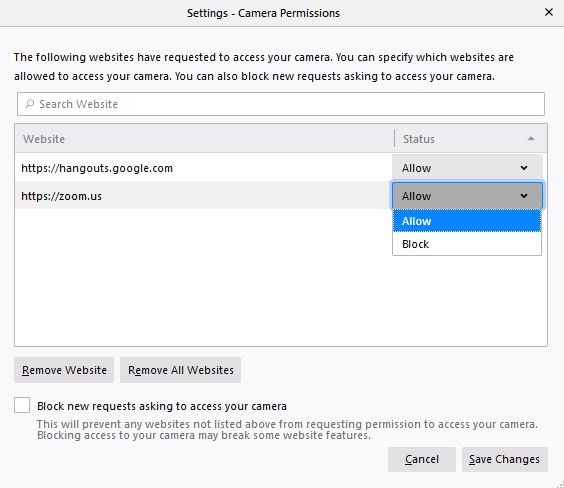
5- Use the Allow/Block modes in status column to change permission for the website. You can remove the site by selecting it from the list and clicking the Remove Website.
6- Select the Block new requests asking to access your camera checkbox if you do not want to give any other sites access to your camera.
7- Click the Save Changes button.
Also, you can changing camera permissions.
1- Click the menu button and select Options.
2- Click Privacy & Security from the left menu. Then Scroll down to the Permissions section.
3- Click the Settings button for the Microphone option.
4- Firefox displays the websites with saved Allow or Block permission.
5- Use the Allow/Block modes in status column to change permission for the website. You can remove the site by selecting it from the list and clicking the Remove Website.
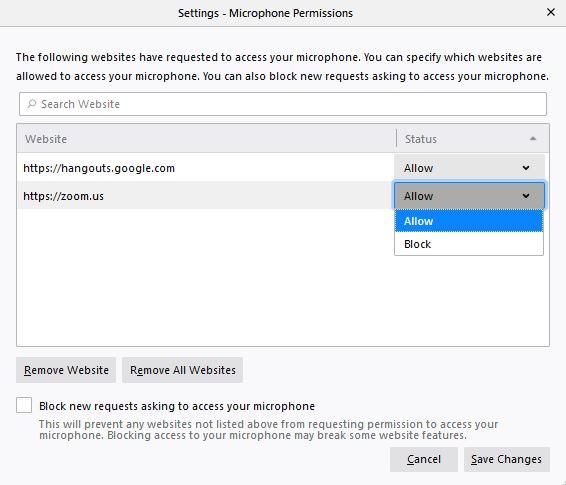
6- Select the Block new requests asking to access your microphone checkbox if you do not want to give any other sites access to your microphone.
7- Click the Save Changes button.
You can use Firefox’s address bar to clear camera or microphone permissions for a site:
Click the lock icon that displays in the address bar on the left. Any relevant permission statuses for the current site are displayed in the Permissions section of the Site Information drop-down panel.
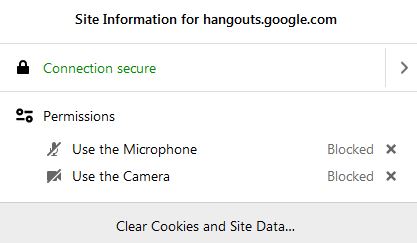
As you can see in the picture, you can easily set the permissions of this website for camera and microphone.

These features are turned on by default so. Phishing and Malware Protection options can be found on the Privacy & Security panel:
1- Click the menu button and select Options.
2- Click on the Privacy & Security panel.
In the Security section, put a check mark next to the following settings to activate them:
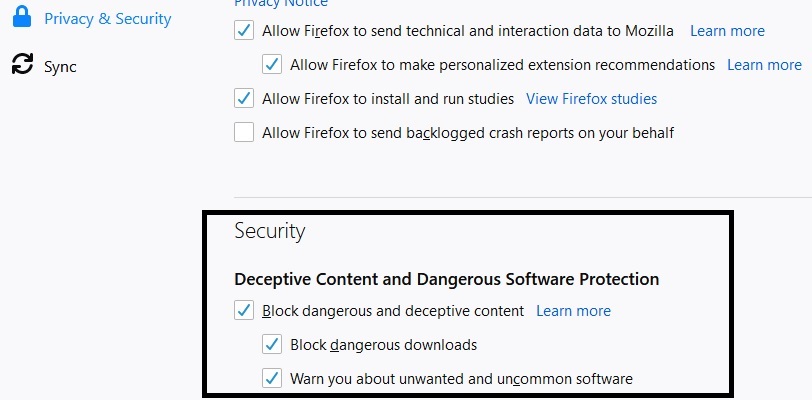
Block dangerous and deceptive content: Check this box if you want Firefox to block potential malware or content that can trick you into downloading malware or unintentionally entering information.
You can refine your choices by checking or unchecking the following items:
- Block dangerous downloads: It Blocks potential viruses and other malware.
- Warn you about unwanted and uncommon software: It Lets you know if you’re about to download potentially unwanted software or uncommon software that may contain a virus or make unexpected changes to your computer.

A secure website certificate helps Firefox determine whether the site you are visiting is actually the site that it claims to be.
When you visit a website whose web address starts with https, your communication with the site is encrypted to help ensure your privacy. When you have browsed to a website whose web address starts with https, there will be a lock icon at the beginning of the address bar.
When you visit a secure website, Firefox will validate the website’s certificate by checking that the certificate that signed it is valid, and checking that the certificate that signed the parent certificate is valid and so forth up to a root certificate that is known to be valid.
You can view the certificate details for the website that you are currently viewing, from the Firefox Page Info window. Do the following to view a certificate:
1- Click the lock GreyPadlock icon in the address bar.
2- Click the right arrow in the Site Information drop-down panel.
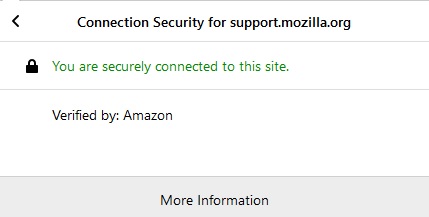
3- In the next panel, which will show who verified the certificate, click the More Information button.

4- From the Security tab in the Page Info window that opens, click the View Certificate button.
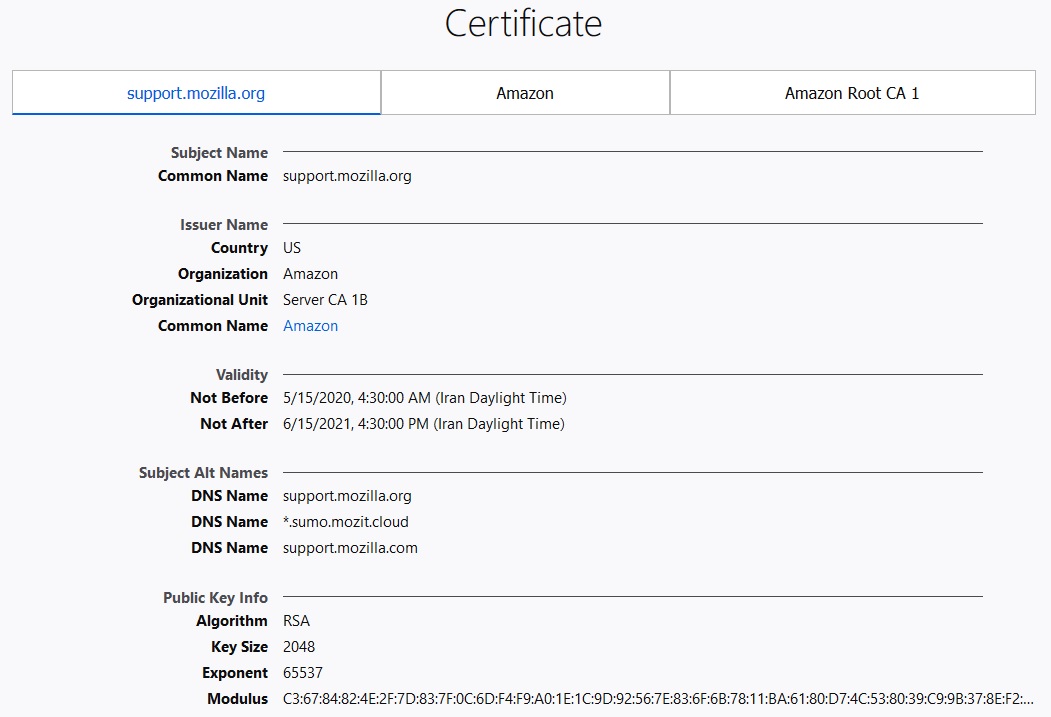
Source: Mozilla Firefox official website



















